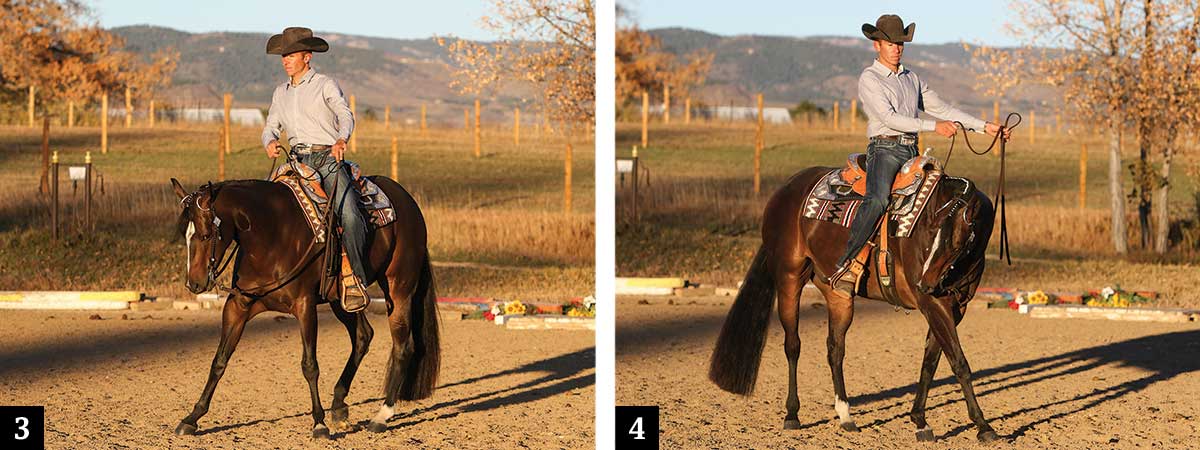If you approach a lead change with your horse’s head looking in the direction of the lead he’s on, he must move his head, neck, and shoulders when you cue for the lead change. It’s almost as if he must uncurl his entire body to change his arc before he can change leads.
For a more polished lead change, manage your horse’s shoulders and ribcage during your approach with this counter-bend exercise. Ride with two hands to start. Work in an arena with plenty of room for long, straight lines and circling off the line when necessary. The instructions work from a left lead to a right lead. Swap to work on your right-to-left change.

One
First, try the counter-bend from a stop. This way you can get the feel for what you’re trying to achieve and teach your horse the response you’re looking for. In this example, we were loping on the left lead, preparing for a change to the right lead. My horse’s body was bowing out to the right, with his head looking left. I stopped him in his tracks, and now we’ll begin working the counter-arc drill.
Two
With my right rein, I tip my horse’s nose to the right. My left rein is in a supporting position, but with slack so my horse can move to the left. My right leg places pressure on my horse’s ribcage, behind the cinch, to push that bow in his body and straighten him out. My left leg is in a supporting position to maintain the forward motion necessary to keep my horse moving as we work through this exercise.

Three
I maintain that same pressure, with more weight in my right hip to continue to push my horse’s ribs to the left. This is similar to an overcorrection for a horse that dives into a directional change. I push and guide with more pressure in the opposite direction to rebalance my horse for more straightness.
Four
I continue this in a slow, methodical manner to keep my horse from getting frustrated or scared. I can lift my hands, as I have here, if I feel like he’s getting too heavy on his front end to help elevate his shoulders and “unstick” his front feet if they seize up. I’ll continue these steps to the left until we’re back at our starting point. Then my horse will be set up to lope off on his right lead.

Five
We can do the same exercise at a lope once my horse understands how to respond when doing it from a stop. My horse was loping on the left lead, approaching a right-lead change. He was looking to the left instead of staying straight, so I take him off the straight path and start our counter-arc exercise, this time with forward motion at the lope. You can see that my body position here is exactly the same as it was in Photo 4, and I’m getting a similar response from my horse.
Six
I continue to guide my horse along the circle with his body arced toward the inside and his nose tipped out. Once I feel like he’s adequately responded to my cues to move his shoulders, ribs, and nose as I’ve asked, I release and we go back on our straight path. I should be able to push my horse’s body around as needed, thanks to building his response with this counter-arc drill.

Seven
This time when I rode across the pen, my horse stayed straight from his nose to his tail. He didn’t look toward the lead he was on, and his body didn’t bow against my leg. We maintained that straightness and achieved a solid, straight lead change.
Seth Fender, Loveland, Colorado, specializes in preparing all-around horses for youth, amateur, and open competition of all levels. He’s a lifelong horseman who understands the need to tailor training and coaching programs to individual horses and riders. He’s trained and exhibited world champions and top-10 finishers in both AQHA and APHA competition. Learn more at sethfender.com.

